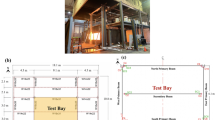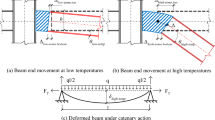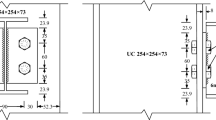Abstract
Steel connections play a crucial role in maintaining the integrity and stability of steel building frames especially when exposed to fire temperatures. The behavior of flush endplate connections in fire is shown to be governed by tension bolt failure as bolts lose their strength and stiffness more rapidly at higher temperatures. As a result, the ability to predict the development of stresses in tension bolts of flush endplate connections at different stages of fire is of special importance. One of the factors influencing bolt stresses in fire is the thermal creep or time-dependent inelastic response of steel to elevated temperatures. Therefore, time- and temperature-dependent behavior of tension bolts of flush endplate connections in fire is the focus of this study. Stress-time histories in tension bolts are obtained by explicit consideration of thermal creep of steel in FE models of flush endplate connections at elevated temperatures. To better understand the effect of thermal creep on tension bolt behavior, the correlation between time-dependent rotational deformation of flush endplate connections and bolt stresses is also investigated. Further, the isochronous representation is utilized to study the rotational deformation and the tension bolt stresses under various applied moments ranging from 50% to 95% of the moment capacity and fire temperatures ranging from 450°C to 600°C with 25°C increment. Through such representation, it is indicated that the connection behavior is not only dependent on bolt strength degradation and applied moment, but also affected by the time duration of applied moments and temperatures. Also, with the inclusion of thermal creep of steel, the connection experiences higher rotation and excessive endplate deformation with stress relaxation leading to top tension bolt failure at earlier stages of fire. More specifically, for time exposure greater than or equal to 60 min, the failure temperature of the connection decreases from 600°C to around 550°C. Therefore, neglecting thermal creep of structural steel may result in an unsafe prediction of the overall response of flush endplate connections in fire.














Similar content being viewed by others
References
Li J-T, Li G-Q, Lou G-B, Chen L-Z (2012) Experimental investigation on flush end-plate bolted composite connection in fire. J Constr Steel Res 76:121–132
Yu H, Burgess I, Davison J, Plank R (2011) Experimental and numerical investigations of the behavior of flush end plate connections at elevated temperatures. J Struct Eng 137:80–87
Gao Y, Hongxia H, and Gang S (2013) Resistance of flush endplate connection under tension and shear in fire. J Constr Steel Res 86:195–205
Al-Jabri K S, Seibib A, Karrech A (2006) Modelling of unstiffened flush end-plate bolted connections in fire. J Constr Steel Res 62:151–159
Harmathy TZ (1967) A comprehensive creep model. J Basic Eng Trans ASME 89(3):496–502
Harmathy TZ, Stanzak WW (1970) Elevated-temperature tensile and creep properties of some structural and prestressing steels. Fire Test Perform ASTM STP, 464:186–208
Knight D, Skinner DH, Lay M G (1971) Prediction of isothermal creep. BHP Melbourne Research Laboratories, Report MRL 18/2, The Broken Hill Proprietary Company Limited Australia, pp 1–14
Skinner DH (1972) Determination of high temperature properties of steel. BHP Tech Bull 16(2): 10–21
[9] Fujimoto M, Furumura F, Ave T, Shinohara Y (1980) Primary creep of structural steel (SS 41) at high temperatures. Trans Archit Inst Jpn 296: 145–157
Fujimoto M, Furumura F, Ave T (1981) Primary creep of structural steel (SM 50A) at high temperatures. Trans Archit Inst Jpn 306: 148–156
Fujimoto M, Furumura F, Ave T (1982) Primary creep of structural steel (SM 58Q) at high temperatures. Trans Archit Inst Jpn 319: 147–155
NIST (2005) Final report on the collapse of the world trade center towers. Report NIST NCSTAR 1, National Institute of Standards and Technology, Gaithersburg, MD
Luecke, WE (2005) Federal building and fire safety investigation of the world trade center disaster—mechanical properties of structural steels (draft). Gaithersburg, MD: Report NIST NCSTAR 1-3D, National Institute of Standards and Technology
Morovat MA, Lee J, Engelhardt MD, Helwig TA, Taleff EM (2011) Analysis of creep buckling of steel columns subjected to fire. Structures Congress, ASCE, pp 2929–2940
Morovat MA, Lee J, Engelhardt MD, Taleff EM, Helwig, TA, Segrest VA (2012) Creep properties of ASTM A992 steel at elevated temperatures. Adv Mater Res 446–449:786–792
Huang ZF, Tan KH, Ting SK (2006) Heating rate and boundary restraint effects on fire resistance of steel columns with creep. Eng Struct 28: 805–817
Li GQ, Zhang C (2012) Creep effect on buckling of axially restrained steel columns in real fires. J Constr Steel Res 71:182–188
Kodur VKR, Dwaikat MMS (2010) Effect of high temperature creep on the fire response of restrained steel beams. Mater Struct 43:327–1341
Li G-Q, Guo S-X (2008) Experimental on restrained steel beams subjected to heating and cooling. J Constr Steel Res 64:268–274
Toric N, Harapin A, Boko I (2013) Experimental verification of a newly developed implicit creep model for steel structures exposed to fire. Eng Struct 57:116–124
El Ghor AH, Hantouche EG, Morovat MA, Engelhardt MD (2016) Creep behavior of flush endplate connections at elevated temperatures due to fire. In: Structures in fire proceeding of the ninth international conference, Princeton University, New Jersey, USA, pp 435–442
El Ghor AH, Hantouche EG (2017) Thermal creep mechanical-based modeling for flush endplate connections in fire. J Constr Steel Res 136:11–23
ABAQUS version 6.14 [Computer software]. Dassault systemes, Waltham, MA
Fields BA, Fields RJ (1989) Elevated temperature deformation of structural steel. Report NISTIR 88-3899, NIST, Gaithersburg, MD
Boresi, AP, Schmidt RJ (2003) Advanced mechanics of materials. Wiley, New York
Norton FH (1929) The creep of steel at high temperatures. McGraw-Hill Book Company, Inc, New York
Lee J, Morovat MA, Hu G, Engelhardt MD, Taleff EM (2013) Experimental investigation of mechanical properties of ASTM A992 steel at elevated temperatures. Eng J 50(4):249–272
Hu Y, Davison JB, Burgess IW, Plank RJ (2007) Comparative study of the behaviour of BS 4190 and BS EN ISO 4014 bolts in fire. In: Proceedings, ICSCS, Taylor & Francis, London, pp 587–592
Acknowledgements
The authors gratefully acknowledge the financial support provided by the American University of Beirut Research Board under Grant No. 103371-23310, and by the Lebanese National Council for Scientific Research (LNCSR) under Grant No. 103091-22968. The authors further would like to thank researchers at the University of Sheffield for making the connection test results publicly available.
Author information
Authors and Affiliations
Corresponding author
Rights and permissions
About this article
Cite this article
El Ghor, A.H., Hantouche, E.G. & Morovat, M.A. Flush Endplate Connections in Fire: Time-Dependent Behavior of Tension Bolts. Fire Technol 54, 1149–1169 (2018). https://doi.org/10.1007/s10694-018-0736-9
Received:
Accepted:
Published:
Issue Date:
DOI: https://doi.org/10.1007/s10694-018-0736-9




